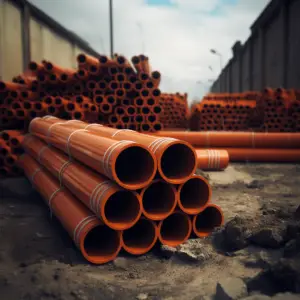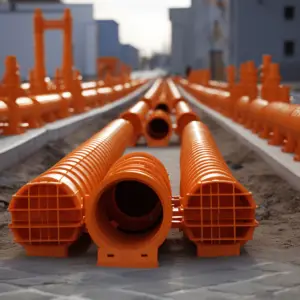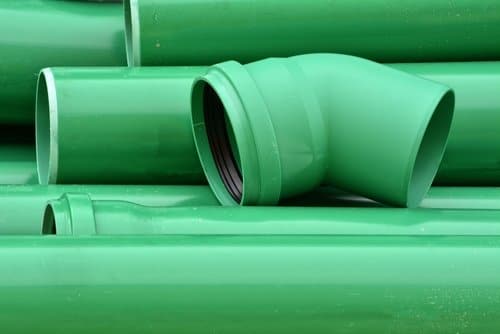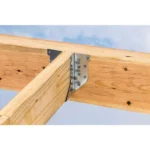SDR 35 and Schedule 40 Pipes, Downspout and wastewater drain lines can be a real headache. If they’re not strong and flexible enough at the joints, they can have serious problems when cold weather and frost heaves cause the lines to displace. This includes issues with sewer leakage and potential contamination of ground and water supplies.
Fortunately, SDR 35 Vs Schedule 40 pipes are two common options that you may consider. But which among the two is most suitable for underground downspout and sump-pump drain lines?
Well, it’s possible to get confused about the performance between SDR and Sch 40. So, here’s a bit more on these two options and how each can benefit your water utility in the field.
Table of Contents
SDR 35 Vs Sch 40: Overview

Utilized mainly in stormwater and gravity-fed waste elimination systems, SDR 35 (Standard Dimension Ratio) is a medium-strength pipe that falls between Schedule 20 and Schedule 40 PVC pipe. It is highly resistant to chemicals commonly found in sewage and industrial waste.
Standard Dimension Ratio typically refers to the ratio of the outside diameter of a pipe to the pipe wall thickness. That is to say, a pipe that is rated SDR 35 has a diameter 35 times larger than its wall thickness. SDR 35 comes in 14’ lengths and is compatible with both the Schedule 20 glue fittings as well as SDR 35 gasket fittings.
On the other hand, Sch 40 or rather Schedule 40 pipes are generally harder, stronger, and rigid. They have thinner walls, which makes them best for applications that involve relatively low pressure.
Difference between SDR and Schedule 40
Standard Dimension Ratio Pipes are typically designed with the ability to bend with the shifting and settling. Note that having higher flexibility tolerance means fewer breaks from soil conditions.
Schedule 40, on the other hand, looks better on paper; generally harder and stronger to crush. Usually, when it comes to it, people tend to pick the stronger material. So, could this be your right choice? Hold on because there’s a downside to it.
Schedule 40 is so rigid that if the ground shifts or settles, this pipe has no give. SDR 35 and Schedule 40 Pipes will just snap or break from the pressure. Also, during winter, Schedule 40 becomes more brittle from being outside.
In order to determine the best option between the two, we have to consider what both strength and flexibility mean in this context and how they apply. We suggest you hold your conclusions until the end.
Schedule 40 vs. SDR 35: Strength or Flexibility?
When you think of strength, you most likely go right to the core of what it is. While this can lead you to believe that Schedule 40 is a better choice, it’s important to take a closer look at both types.
SDR pipes are designed and meant to be more flexible in comparison to Schedule 40. They basically compromise structural integrity for flexibility. As such, it may not seem like it would go along with what some people would want.
But on the bright side, it offers more flexibility. The grounds are always shifting and settling, and while these lines are installed underground, they will be prone to these changes. This is exactly where the SDR’s flexibility beats the strength of Schedule 40.
SDR 35 and Schedule 40 Pipes bends with the shifting and settling. Higher flex tolerance means fewer chances of breaks due to varied soil conditions. Schedule 40 is hard and rigid that on the off chance the ground shifts or settles this pipe has no room for adaptability. It will simply break or snap from the pressure.
In the winter, Schedule 40 is likely to become more brittle due to exposure. The weather alone can compromise the structural integrity of Schedule 40 in just a few seasons.
Minimum Depth for Placing SDR 35 vs. Schedule 40

Due to its flexibility, the SDR 35 can be buried shallow or deep without the likelihood of cracking. The pipe should be placed at least 12 inches into the ground, but going down to, say 24 inches is better. The minimum wall thickness for SDR 35 pipe ranges from 0.12 to 0.47 inches.
Note that driving over a buried SDR pipe is acceptable as long as it’s positioned at the right depth and surrounded by the right soil. The pipe’s great flexibility transfers much of the weight/load to the surrounding earth. It is strong enough to be buried fifty feet underground, yet flexible enough to eliminate shear or beam failures.
On the other hand, the minimum cover when placing Schedule 40 outside or under concrete is 4 inches. However, it is under a building, there’s no depth requirement.
The Bottom Line
All things considered, we recommended using SDR on the exterior of your home, especially for long-term purposes. The flexible nature of the line will keep it from breaking from possible adverse conditions. Keep in mind that these lines will require a gasket or solvent weld to make sure the connection points are secure.
You may also want to consider closing the system completely between the entry and exit points to keep roots from inflating your line. SDR 35 is considered less susceptible to the elements compared to Schedule 40, mainly because it can distribute or rather transfer much of the load to its surroundings.
With proper installation, SDR 35 is one of the top choices available on the market today. It is a superior quality line that can help protect your investment in the long run.


